In the United States, there are more than 1.5 million[1] registered non-profits. The number is overwhelming, and it means as a donor, you have to weed through a lot of organizations to determine where to give. Most donors want to support high performing organizations, but it is difficult to assess the performance of an organization when its bottom line is mission rather than dollars. The truth is that while all non-profits presumably exist to do good, what they actually are able to achieve in terms of impact can vary dramatically. So, how do you assess the high-impact organizations?
Generally, non-profits tend to fall onto a spectrum that can broadly be broken down into three buckets, high-performers, average-performers, and under-performers. Most non-profits fall some one near the middle of this spectrum with a few under-performers and a few really high-performers. Importantly, none of the characteristics of these groups are absolute and some organizations may have some traits from each category. Also, organizations learn and grow as they go so they may move from being, for example, an average non-profit to a high-performing organization. It’s important to watch organizations as they change and grow and continually reassess their impact.
one near the middle of this spectrum with a few under-performers and a few really high-performers. Importantly, none of the characteristics of these groups are absolute and some organizations may have some traits from each category. Also, organizations learn and grow as they go so they may move from being, for example, an average non-profit to a high-performing organization. It’s important to watch organizations as they change and grow and continually reassess their impact.
Under-performers tend to be the easiest organizations to identify and weed out. These are the organizations that have alarming financial data, cannot articulate their mission and programs clearly, have little or no data on the outcomes or impact they have provided, and weak leadership, and little or no board involvement. You may even question whether these organizations are really “doing good.” Online resources like Charity Navigator and Guidestar do a pretty good job at identifying under-performers in the space. As a funder, it is usually best to avoid these organizations.
The vast majority of nonprofit organizations fall somewhere in the middle of the spectrum. They do a good job fulfilling their mission and meeting a need within the community and can clearly articulate how they do this. Financially, these organizations have some stability (although mostly likely heavily rely on grant funding) and no questionable financial practices. They have good leaders running the organization and have some board involvement and oversight. When asked about outcomes, they can talk about the number of people they have served, or the acres of land they have saved. They have often developed a model for change that works for the people they are directly serving but may not be applicable beyond those people.
On the other end of the spectrum are the high-performing organizations. These organizations check all the boxes of an average-performer including board engagement, responsible financial practices, good leadership, and clearly articulated mission and goals but then move beyond that. They may be big or small, but in terms of impact they are able to “punch above their weight.” It can be hard to define exactly what makes these organizations so effective, but based on what I have seen, the key is that they think and act outside the organization itself. These organizations have an outward looking eye that defines the problem they want to solve more broadly than just the people they are able to directly serve. High-performing organizations don’t just want to fix a problem for the people they serve every day but they want to fix it for everyone. In business terms, these organizations define themselves by the market they serve rather than by a particular product or service. In order to achieve this goal, high-performing organizations seek and leverage help externally. They think about where they fit in a system and tailor their services to meet the unmet in within those broader systems. They also learn from others and consistently seek outside input and advice. High-performing nonprofits demonstrate the following characteristics:
- Leverage external resources—high performing organizations think and act beyond just their own organizations. They are familiar with broader systems and players within the social sector and take advantage of them to promote their own mission. They are willing to tap resources far beyond their own organization and when they encounter a road block they don’t look internally for the answer; they look at what the field is doing and saying and learn and grow from the advice of others
- Catalytic leadership—the people leading these organizations possess all the great qualities that it takes to internally create a strong organization, but these leaders are also able to have a broad view outside their organizations. They are collaborators, innovators, and problem solvers. They are willing to admit they cannot solve every problem for their constituents and are therefore willing to work alongside others to fill all the needs for the people they serve.
- Advocate for change—high-performing organizations believe beyond a doubt in their mission to help others and are willing to advocate for the mission in policy discussions, with funders, and with other organizations. They believe that nothing is set in stone and will advocate for change if that means they will better fulfil their mission. Their actions change laws, transform cultures, catalyze social movements, and transform funding policies.
- Measure and track outcomes—Measurement of impact is hard, but the best organizations are trying to do it. They believe that only by tracking and understanding their impact will they learn how to better solve problems and fulfill their mission. They are rigorous and don’t think of measurement as a distraction but rather a part of creating the change they seek. When talking about outcomes, they can talk about the number of men they have kept out of jail, and the cost savings this has provided to society as a whole not just the number they have served.
The bar is high to become a high-impact organization, but they are out there and do exist. Finding these organizations can take a great deal of research and many conversations; you won’t be able to identify them through any websearch. As funders, it is exciting to find these organizations and support their mission not just for the sake of their mission but because these are the organizations that will truly transform the field. The time you spend in finding them is well worth the return you will see in impact.
[1] Includes public charities, private foundations, and other types of non-profit organizations


Leave A Comment
You must be logged in to post a comment.